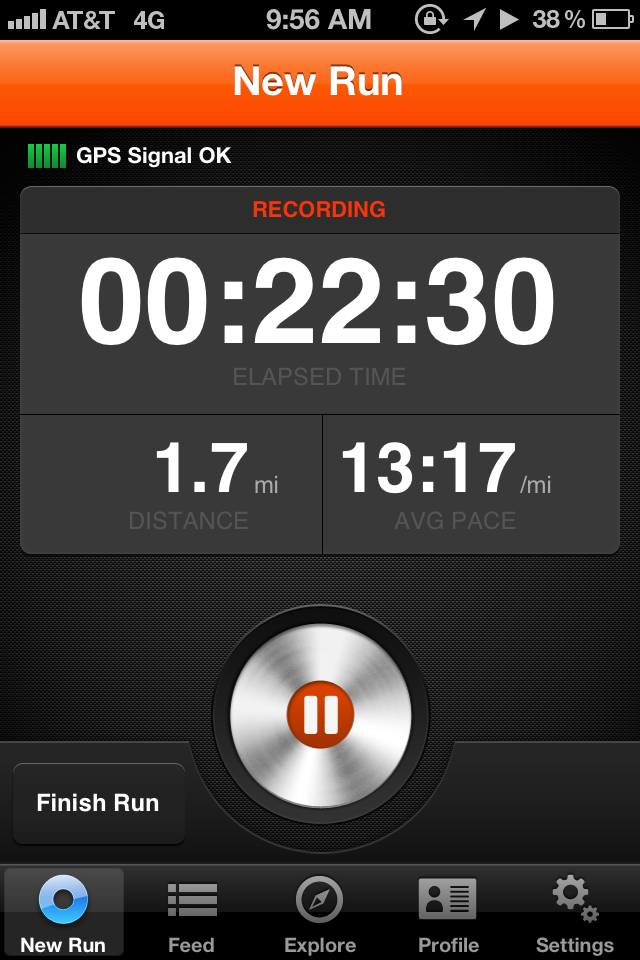
In May of 2006, Apple teamed up with Nike to announce a running tracker for use with the iPod nano. To put this moment in perspective, Apple had just opened its now-iconic flagship Fifth Avenue store days earlier. Usain Bolt shook in his golden Puma shoes as the world was encouraged to get off its collective behind and run with the help of their music players. Apple and Nike kept the momentum in 2009 when Apple announced its iPhone 3GS with built-in Nike+ support, and again in 2010 with the Nike+ GPS app, which eliminated the need for its proprietary shoe sensor. 2012 brought NikeFuel, a proprietary point system that tracks your activity; it's like a calorie, but with more dancing cartoon characters. Nike ruled the running roost and, for a time, it was good. But with all its success, Nike’s cumbersome Web interface for Nike+ was left to languish, and its competitors caught up. Developers took advantage of the iPhone’s GPS capabilities and created a whole host of outdoor running apps, attempting to topple the king that was Nike+.
Finally, in June of this year, Nike redesigned its entire Nike+ offering. Since we have a small (but growing) contingency of runners at Ars, we wanted to see how Nike's updated Nike+ Running app stacked up against some of the competition.
Strava Run
Strava looks fantastic. The simple Web interface is accompanied by an even lovelier mobile UI for iOS and Android devices. Nike+ has its bells and whistles that encourage the average Joe to get off their couch, but Strava's clean interface seems to be more appealing to those who already wake up at 5am and just want a no-nonsense analysis of their performance. In addition to tracking your data, it allows you to plug in your latest endeavor manually, along with the ability to track your routes via GPS. Integration with various Garmin devices is also available, should you not want you take your iPhone along for your trek. But not everything is roses: Strava’s social features are pretty shallow. While you can add friends, share runs with the requisite social networks, join clubs, and compare stats down to the section of road, there’s no way to directly challenge a buddy in a race or achieve a goal together—a much-loved feature in Nike+. Strava offers its own “Strava Challenges," which are running or cycling goals that encourage certain aspects of training such as climbing a certain number of feet or beating your personal best. Depending on your locale, however, their challenges can be impossible to complete and therefore may end up being useless to you.

Signing up for an account via Strava's signup form or Facebook was simple, and within minutes I was ready to strap on my FiveFingers and go out for a light jog. Right away, a huge disappointment that I discovered during my run was the lack of on-screen audio controls. My running headphones aren’t remote-equipped, so changing tunes was a task that severely hampered my pace.
Strava offers a premium subscription plan, which adds an incredibly detailed analysis of your activities as well as filtered leaderboards based on age and weight to see how you measure up to your competition. While it isn’t for everyone, I found myself wondering if I should at least try the premium plan just to see if I would enjoy the extra data points. Strava's premium features do come at a pretty high cost for what you get, though. For $6 per month or $60 per year, Strava charges a pretty penny for its more detailed analysis of your performance. While some of the features may seem a little gimmicky ("Suffer Score"? Really?), serious statistics-oriented athletes may still relish the extra details.
After my run, I felt conflicted about how to think about Strava. Nike’s app was better suited for my song-changing disposition, while Strava’s simple interface encouraged me to crunch numbers like an out-of-shape Ivan Drago. I found myself glancing at the app’s simple display of my stats throughout the day, something I’ve never done with Nike+. There were no emoticons asking me if it was chilly outside, no prominently displayed buttons asking me to share my less-than-ideal workout with others. And while I don’t think I’m ready to switch from Nike+, Strava delighted the statistician in me by showing me the raw numbers.
RunKeeper
RunKeeper is another longtime competitor in the fitness tracking game, using GPS and manual entry to track your running, cycling, or even cross-country skiing activities. The app seems to be the preferred alternative to Nike’s offering, boasting over 6 million users in 2011.
What sets RunKeeper apart from the rest of the pack is the amount of data that it allows you to store within your profile. You can track your weight loss and fitness level as well as your sleeping habits. The ability to see multiple data points and how they relate to one another is delightful, and is no doubt useful to someone who wants to see if their habits have any correlation with one another.
RunKeeper’s website is one of the more bland entrants in the design category. While Strava’s interface is decidedly minimal and Nike’s colorful, RunKeeper seems to be aiming for a unique kind of “boring” aesthetic. On the plus side, it does let you enter information manually, something Nike does not allow. The iOS and identical Android app is in a similar predicament; it’s not especially delightful to look at, but it gets the job done. The ability to change the screen orientation is a huge boon for me, as I like to take a glance at my iPhone while it's strapped to my arm.

RunKeeper’s running mode suffered from an oversight similar to Strava’s app: no built-in playback controls. While you could choose a playlist before you began your run, changing songs involved the same home button double-tap and swiping as it did on Strava’s app. During my run, RunKeeper surprised me with a “coach” that relayed statistics to me every few minutes in a very pleasant voice, similar to Nike’s. And unlike the rest of the apps I tested, RunKeeper's GPS tracking was more precise than the competition. It gave me a reading down to the hundredth of a mile rather than the tenth that has become the norm. Like Nike, a pace/elevation chart was also available, but what comes as a bittersweet feature is the inclusion of speed in the chart. Unfortunately, the speed overlay is the same color as the pace overlay, which is not very helpful when they’re all displayed together.
What may make RunKeeper more appealing than other fitness apps is its Health Graph. Unlike Nike or Strava, RunKeeper allows a variety of fitness apps to access your account and add their own data to it using RunKeeper’s Health Graph API. With the ability to track weight loss, sleeping patterns, diet, and body measurements, RunKeeper is marketing itself as a central hub for all of your health-based activity, running included. Another fitness service, MapMyRun, offers a similar API, but RunKeeper’s Health Graph implementation seems to be significantly more popular. The integration extends beyond apps into physical products like the Withings WiFi Body Scale and FINIS SwimSense Performance Monitor, just to name a few.
In looking for an app that integrates with RunKeeper's Health Graph, I stumbled upon the weightlifting-specific app Gym Hero. When asked why he decided to use RunKeeper's Health Graph, Gym Hero cofounder Jannis told me it was mostly about consolidation. “We’re a two-man gang doing this next to our day job, so creating our own graph was out of the question. We wanted to build upon the health graph because it’s a great idea (consolidating all your health related data in a place that’s open and where you can pull out your own data anytime)," he told Ars.
The Health Graph, app promotion on its site, and a dedicated following make RunKeeper quite popular despite some of its downsides. It is pretty easy to see why. With a fresh coat of paint, RunKeeper could be the ideal fitness database for developers and users alike.
Nike+ Running
Nike’s now-redesigned experience was a much-needed change to the company's previous unusable site and buggy iOS app. First, Nike added to its iOS app GPS coordinates for your outdoor runs along with a map of your route, viewable (sometimes) on Nike’s website. No longer is the Nike+ sensor necessary to track your runs through the wild roads of suburbia.
On the app's splash page, Nike prominently displays your total miles along with information pertinent to the masses like number of runs, calories burned, and the day you last ran. Any goal you have created on the website shows up at the bottom of the screen, a little reminder of a promise you once made to yourself and can still keep if you put those sneakers on. The ability to start a run almost always remains in a corner, save for when looking at a previous run.
But a feature I previously took for granted in Nike+ Running was its music integration. Where I would occasionally pause a workout when attempting to change a song, the buttons now have their own section in their respective corners. Touchscreen mishaps are now a thing of the past with this new layout, and switching songs has never been easier—an oversight by almost every other running app I looked at.

The run was pretty accurate in my experience, never missing a beat when I climbed a set of stairs or decided to do some light fartlek training. The soft voice of what I can only assume to be Siri’s more beloved sister popped up, informing me of my pace and distance. When finished, you have the option of syncing your run with Nike’s online presence.
On Nike’s redesigned website, nearby routes that were plotted and named by other runners are suggested to you as well. I’m not a man who would go four miles away from his home to run another four miles, but I did see the appeal in this feature. When synced and viewed online, a visual representation of your pace as it relates to your elevation is shown underneath your GPS route. After I synced my most recent run, the shockingly abrupt and flashy appearance of Fuelee, Nike+’s mascot, alerted me to an achievement of sorts: my fastest 5K. (I closed his little window, silently hoping that I would see him do yet another jig the next time I logged in for some other unforeseen accomplishment.)
The price to be a part of Nike’s + community has steadily decreased since its inception, no doubt due to free alternatives that may lure prospective buyers away. With somewhat pricey options like the Nike FuelBand, SportWatch GPS, and SportBand, the purchase of an iOS or Android device is enough to get you in the club. And although each runner has his or her own preferences when it comes to apps, the Nike+ Running app is still top dog in my book. Its appealing interface, both mobile and stationary, makes it easy to learn and use. And its use of NikeFuel, while forgettable, is just interesting enough to keep me running a little longer. I’m coming for you, Usain.
reader comments
65